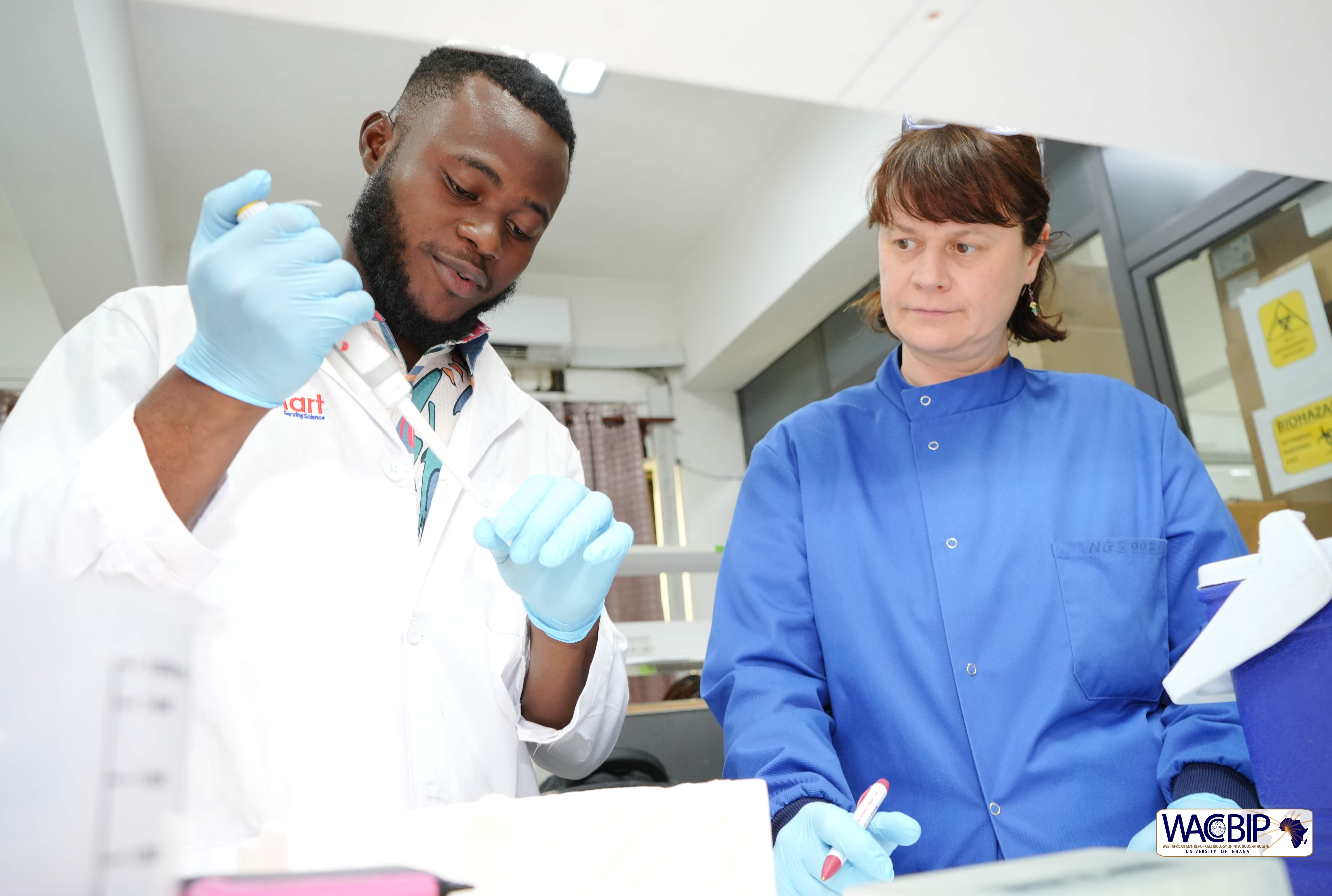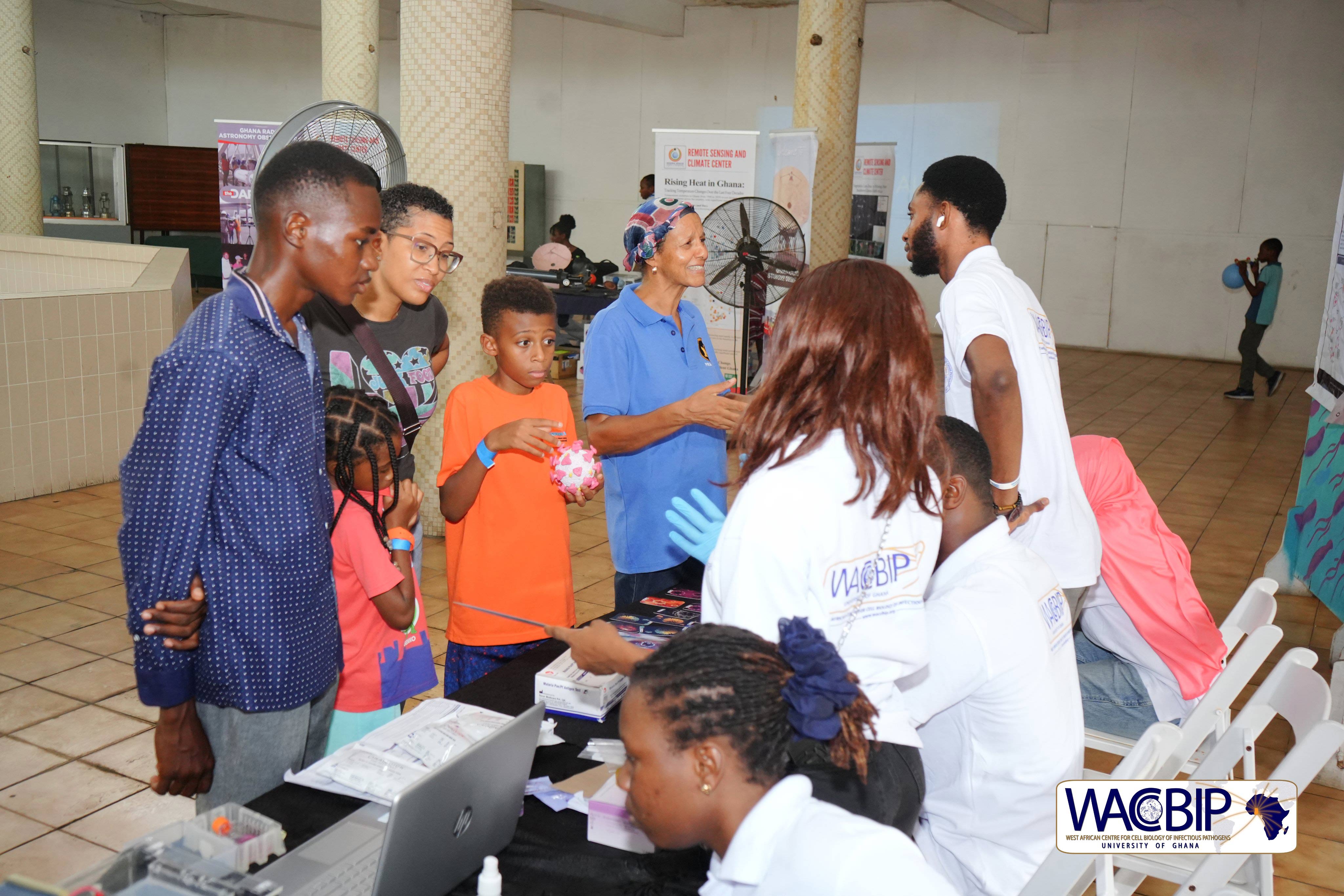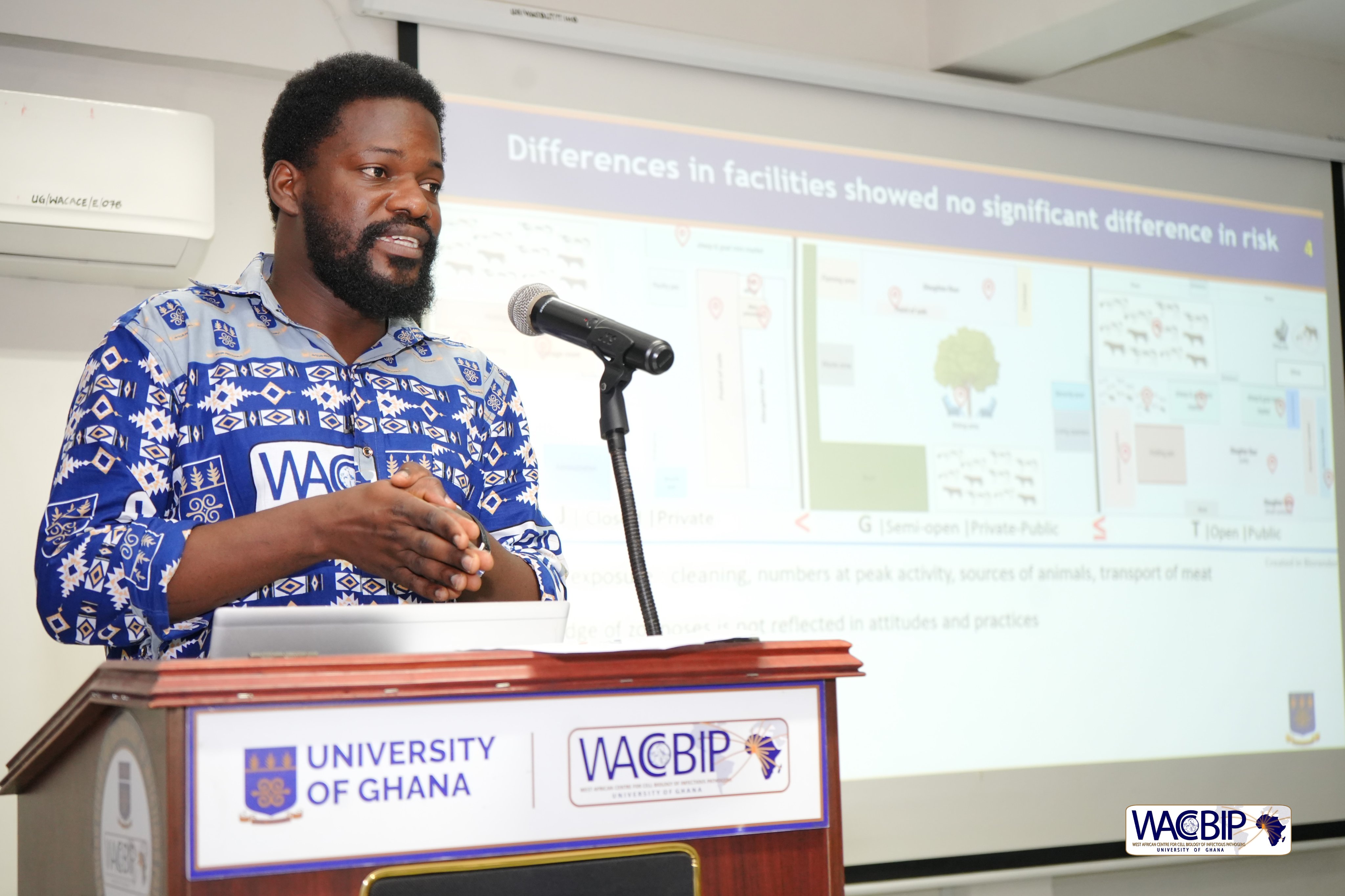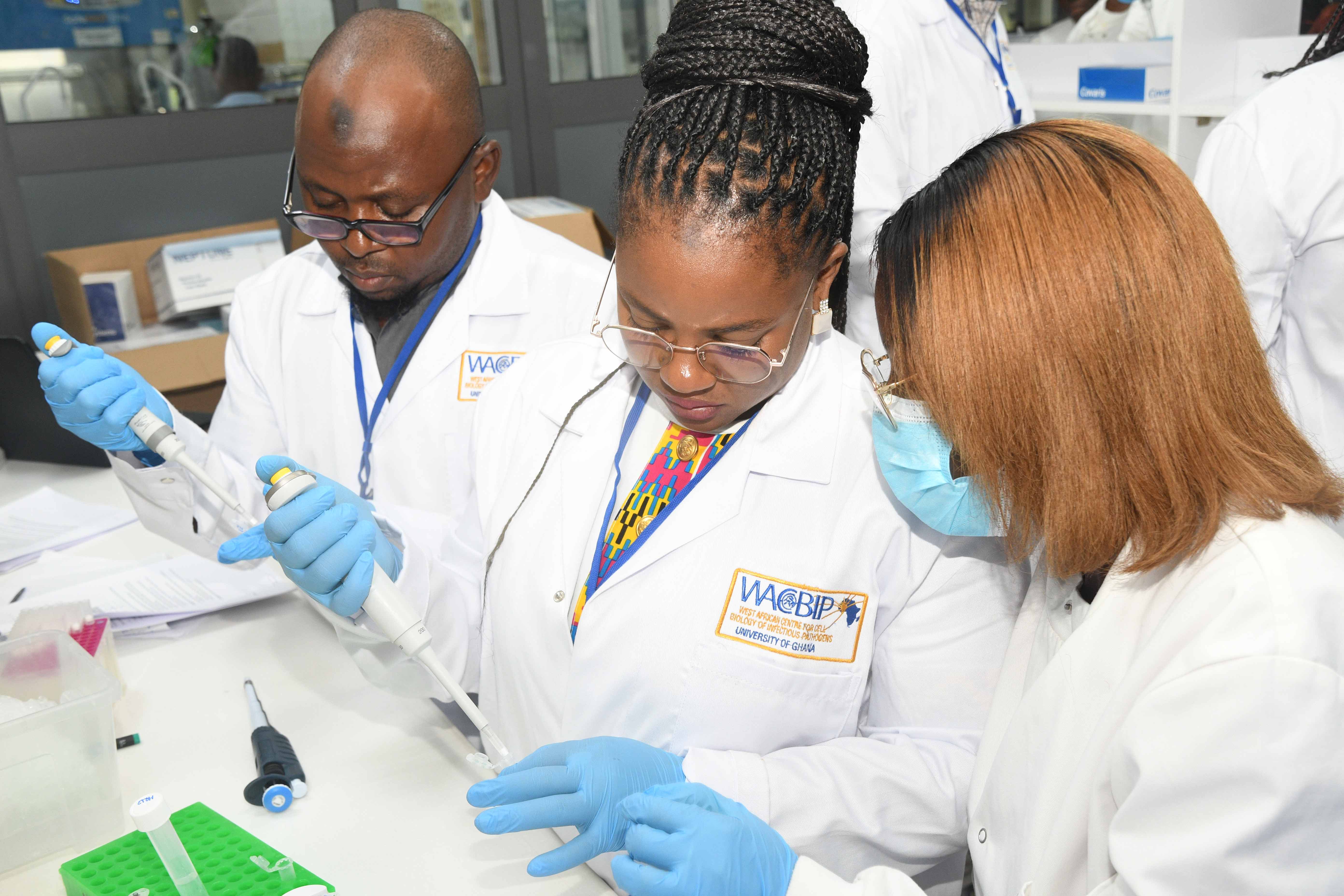MOSI RESEARCH GROUP
The group focuses on carrying out hypothesis-driven research in microbiology and also seeks to provide evidence-based solutions to the challenges of infectious diseases in Africa by developing standardized protocols and generating reproducible data using machine learning, microbiological and molecular tools.
The Group is primarily active within the Cell and Molecular Biology Lab.
ABOUT THE GROUP
Mosi Research Group is at the Molecular Biology section of WACCBIP. The group focuses on carrying out hypothesis-driven research in microbiology and also seeks to provide evidence-based solutions to the challenges of infectious diseases in Africa by developing standardized protocols and generating reproducible data using machine learning, microbiological and molecular tools. The group is led by Dr. Lydia Mosi, a Microbiologist with focus on Microbial pathogenesis. Lydia Mosi teaches Molecular biology, bacterial infections, molecular genetics, molecular biotechnology, experimental techniques and veterinary biochemistry at University of Ghana, where she continues her years-long study of Buruli ulcer.
Research Themes
Buruli ulcer is a skin ulcerative disease caused by Mycobacterium ulcerans. Our group seeks to exploit multidisciplinary approaches that will aid in identifying the niche of the bacterium in the natural environment. Using in silico genomics and functional laboratory studies, we are providing insights into the environmental niche of M. ulcerans and other environmental mycobacteria.
Specifically to;
- Characterize the protein and lipid metabolomes of M. ulcerans and MPMs,
- Identify key M. ulcerans metabolic markers that can be found only in Buruli ulcer patients,
- Isolation of secondary bacterial and fungal infection of Buruli ulcer lesions,
- Utilize antioxidant compounds in attenuating the cytopathic effects of mycolactone to enhance wound healing of Buruli ulcers,
- Integration of computational and laboratory methods to study host-pathogen molecular interactions that could play a role in pathogenesis of M. ulcerans.
Development of diagnostic tests for the rapid detection of M. ulcerans infection has been one of the major focus areas of the WHO Buruli ulcer consortium. The limitation caused by the slow growth rate and unavailability of bacterial antibodies have greatly hindered the rate at which diagnosis is made. The lack of adequate epidemiological and pre-clinical stage data on the disease also compounds the lag on efforts made by researches to date. In addition to this, not much work has been done on identifying markers that can be useful in determining disease prognosis during the prolonged chemotherapeutic duration. I am interested in applying metabolomics to identify metabolic markers that may detect or elucidate different stages of infection of the mycobacterium and also help in the identification of potential targets for the development of a diagnostic test. This cutting edge technique can be applied excellently to help address the short comings of early diagnosis currently experienced in the Buruli ulcer field as described above. The study aims to characterize the metabolome of M. ulcerans with respect to other mycolactone producing mycobacteria.
The mycobacterium genus has evolved diverse mechanisms to thrive under harsh environmental conditions. Mycobacterium tuberculosis, M. marinum and M. bovis engage sporulation mechanism to respond to unfavourable conditions. Since M. ulcerans shares the same genetic ancestry with M. marinum, the pathogen may also form spores. However, M. ulcerans is a slow growing environmental pathogen whose transmission from the environment to humans is less understood; therefore, sporulation in M. ulcerans may be implicated in the transmission of M. ulcerans from the environment to humans.
M. ulcerans produces mycolactone, an immunosuppressant macrolide toxin, responsible for the characteristic painless nature of the infection. Secondary infection of ulcers before, during and after treatment has been associated with delayed wound healing and resistance to streptomycin and rifampicin. However, not much is known of the bacteria causing these infections as well as antimicrobial drugs for treating the secondary microorganism.
Mycolactone induces apoptosis and necrosis leads to large skin ulcers with unknown mechanism of action. Other macrolides with cytotoxic and immunosuppressive properties have been reported to mediate the production of reactive oxygen species (ROS) and mycolactone has been implicated in the mediation of ROS production with respect to keratinocytes. It is important to identify alternative treatment regiments to combat immunosuppression that results in delayed clearance of infection as well as eliminate cytotoxic effect of mycolactone in Buruli ulcer patients. Our study seeks to determine oxidative activity (ROS) in RAW 264.7 macrophages in the presence of mycolactone and assess the effect of antioxidants in the “mop-up” of the produced ROS.
Other mycolactone producing bacteria (MPMs) have been identified to cause granulomas in fish and frog. There are limited advanced genetic tools for studying transmission of the diseases and for carrying out molecular epidemiological studies. The mycolactone producing mycobacteria (MPM), M. shinshuense has been reported to cause Buruli ulcer and other studies have revealed several MPM infections other than M. ulcerans in clinical samples. It is therefore imperative to know the exact MPMs that are in circulation by genotypically distinguishing them using molecular tools.
Cholera has been endemic in Ghana since its detection in 1970. It has been shown that long-term survival of the bacteria may be attained in aquatic environments. Consequently, cholera outbreaks may be triggered predominantly in densely populated urban areas. We investigated clinical and environmental isolates of Vibrio cholerae O1 in Accra to determine their virulence genes, antibiotic susceptibility patterns and environmental factors maintaining their persistence in the environment.
Due to the increasing rate of harvest losses and food wastes approximated at one-third of the food produced worldwide, there is a need to invest into cutting the costs that arise due to the losses. It may be said that more should be invested in prevention of the losses rather than managing it, but some of these losses and wastes can somewhat not be prevented because they are not of anthropic origin. Our group seeks to produce bioethanol, eco-enzyme detergent and fertilizer, hence ensuring a complete recycles of these foods.
Sachet water, popularly known as “pure water” has become an invaluable entity in most Ghanaian households. Despite its importance, there is no extensive nationwide investigation on its wholesomeness for consumption. Our group is determining the microbiological quality of more than 40 brands of sachet water sampled in 16 districts across 5 regions in Ghana.
Additional Research Projects
- The role of Acanthamoeba polyphaga in the transmission of M. ulcerans.
- Development of a diagnostic tool for Buruli ulcer-Point of care test kit using Amoeba as the possible reservoir
- Molecular Characterization of Mycolactone Producing Mycobacteria from Aquatic Environments in Buruli ulcer Non-Endemic Areas.
- Identification of specific metabolites in Mycobacterium ulcerans infection: exploring potential diagnostic biomarkers
- Isolation of bacteria and yeasts associated with fruit fermentation and bioethanol extraction.
- Functional classification of selected oxidate stress response pseudogenes in Mycobacterium ulcerans with respect to acquisition of mycolactone producing plasmid.
Lab Structure
The group is led by Dr Lydia Mosi a Microbiologist with focus on Microbial pathogenesis, and she’s supported by Mrs. Mabel Sarpong (Lab-manager). Dr Lydia Mosi teaches Molecular Biotechnology and its Applications, Bacterial infections, Molecular Genetics, Experimental Techniques and Veterinary Biochemistry at both undergraduate and graduate levels, where she continues her years-long study of Buruli ulcer, antimicrobial resistance and molecular biology.

Dr. Lydia Mosi
Group Members
The research group comprises PhD level research fellows, PhD students, master’s students, research assistants and research interns.
- Banga- Team Research Grant. Amount $50,000. March 2020-March 2021. Role-PI.
- Fleming Fund Country Grant 1 – RFP/GHANA/CG1 National Surveillance for Antimicrobial Resistance. Amount £1.842.669. Jan 2019-June 2020. Role: Co-I
- ACE 003.World Bank grant for establishment of the West African Center for Cell Biology of Infectious Pathogens (WACCBIP) at DBCMB, University of Ghana Legon. $8,000,000. 01/01/2019- 31/12/2024 Role: Co-I.
- UKRI GCRF Capacity building for ultra-long read-length sequencing of Mycobacterium ulcerans to explore transmission dynamics. $65,343. 2018-2010. Role: Co-I.
- Global Challenges research fund – Medical Research Council UK - MR/P024416/1 Identification of specific metabolites in mycolactone producing mycobacteria and Buruli ulcer infection: diagnostic biomarkers through metabolomics. Role: PI. Amount: GBP 250,000. 2017-2019
- Welcome trust Deltas Developing Excellence in Leadership Training and Science funding for WACCBIP – GBP 5,100,000. 2014-2019. Role: Co-I
- Cambridge-Africa Alborada research Fund. Identification of specific metabolites in mycolactone producing mycobacteria. £10,000. 2016. Role -PI
- TWAS - 13-149 RG/BIO/AF/AC_1- UNESCO FR: 3240277707. Functional classification of selected oxidate stress response pseudogenes in Mycobacterium ulcerans with respect to acquisition of mycolactone producing plasmid - $16,000 2014-2016. Role: PI
- University of Ghana Research Fund URF/6/ILG-008/2012-2013. Microbiology of Secondary infections in Buruli ulcer lesions; Implications for Therapeutic interventions. GHC 24, 985. 3/06/2013-31/07/2015. Role: PI
- World Bank - ACE002: African Centres of Excellence, West African Center for Cell Biology of Infectious Pathogens (WACCBIP). $8,000,000.00. 1/2/2014 – 31/12/2018. Role: Co-I
- MSB - SWE-2008-088- Studies on the effects of light exposure on Buruli ulcer healing in a mouse model. $15,000. 01/06/2009-30/05/2012. Role: Co-PI
- Swiss Agency for Development and Cooperation - KFPE-SDC Learning Events Programme for Researchers from Developing Countries. CHF45,000 27/08/2014-03/09/2014. Role: PI
- Afrique One –Wellcome Trust Post-doctoral fellowship. WT087535MA Zoonotic Risks of Non-Tuberculosis Mycobacteria between Humans and Small Mammals (Potential Transmission of Buruli Ulcer) in Cote D’Ivoire and Ghana. GBP 374,500. 01/01/2011-31/12/2014. Role: Post doc fellow
- Mosi L., Mutoji N., Basile F. A., Donnell R., Jackson K. L., Spangenberg T., Kishi Y., Ennis D., and Small P. L.C. 2012 Experimental infection of Medaka (Oryzias latipes) with Mycobacterium ulcerans: A model for transmission, pathogeneses and toxicity to fish. Microb. and infect.; 14(9):719-29.
- Kwofie SK, Enninful KS, Yussif JA, Asante LA, Adjei M, Kan-Dapaah K, Tiburu EK, Mensah WA, Miller WA III, Mosi L, Wilson MD. Molecular Informatics Studies of the Iron-Dependent Regulator (ideR) Reveal Potential Novel Anti-Mycobacterium ulceransNatural Product-Derived Compounds. Molecules. 2019; 24(12):2299. https://doi.org/10.3390/molecules24122299
- Gyamfi, E., Narh, C.A., Quaye, C. et al.Microbiology of secondary infections in Buruli ulcer lesions; implications for therapeutic interventions. BMC Microbiol 21, 4 (2021). https://doi.org/10.1186/s12866-020-02070-5
- Abiola Isawumi and Lydia Mosi (2021). Monitoring antibiotic resistance in Ghana: a focus on hospital environment. REVIVE and GARDP: Advancing Antimicrobial R&D; https://revive.gardp.org/monitoring-antimicrobial-resistance-in-ghana-a-focus-on-the-hospital-environment/
- Daniele O. Konan, Lydia Mosi, Gilbert Fokou, Christelle Dassi, Charles A. Narh, Charles Quaye, Jasmina Saric, Noël N. Abe, Bassirou Bonfoh (2018). Buruli ulcer in Southern Côte d’Ivoire: Dynamic schemes of perception and interpretation of modes of transmission. J Biosoc Sci. Oct 31:1-14.
- Abana D, Gyamfi E, Dogbe M, Opoku G, Opare D, Boateng G, Mosi L. (2017). Investigating the virulent genes and antibiotic susceptibility patterns of Vibrio cholerae O1 in environmental and clinical isolates in Accra. BMC Infect Dis. Jan 21;19(1):76.
- Isawumi A, Donkor JK and Mosi L. In vitroinhibitory effects of commercial antiseptics and disinfectants on foodborne and environmental bacterial strains [version 1; peer review: 1 approved with reservations]. AAS Open Res 2020, 3:54 (https://doi.org/10.12688/aasopenres.13154.1)
- Mosi, Lydia & Adadey, Samuel & Sowah, Sandra & Yeboah, Charles. (2019). Microbiological assessment of sachet water “pure water” from five regions in Ghana. AAS Open Research. 1. 12. 10.12688/aasopenres.12837.2.
- Amoako N, Duodu S, Dennis FE, Bonney JHK, Asante KP, Ameh J, Mosi L, Hayashi T, Agbosu EE, Pratt D, Operario DJ, Fields B, Liu J, Houpt ER, Armah GE, Stoler J, Awandare GA. (2018). Detection of Dengue Virus among Children with Suspected Malaria, Accra, Ghana. Emerg Infect Dis. Aug;24(8):1544-1547.
- Isawumi, M. Kukua Abban, S. Duodu, L. Mosi, M. Valvano (2020). Klebsiella oxytoca: Evolving superbug from Ghanaian Hospitals. International Journal of Infectious Diseases, 101(1):43-44. https://doi.org/10.1016/j.ijid.2020.09.147.
- Abiola Isawumi and Lydia Mosi (2020). SUPERBUGS: Evolving Enemies from Ghanaian Hospitals. PLOS Blogs Global Health Your Say; https://yoursay.plos.org/2020/08/31/superbugs-evolving-enemies-from-ghanaian-hospitals/
- Abiola Isawumi, Abass Adiza, Duodu Samuel, Mosi Lydia. Characterization of culturable airborne bacteria and antibiotic susceptibility profiles of indoor and immediate-outdoor environments of a research institute in Ghana; AAS Open Res2018, 1:17
- Kwofie SK, Dankwa B, Odame EA, Agamah FE, Doe LPA, Teye J, Agyapong O, Miller WA 3rd, Mosi L, Wilson MD. (2018). In Silico Screening of Isocitrate Lyase for Novel Anti-Buruli Ulcer Natural Products Originating from Africa. Molecules. Jun 27;23(7). pii: E1550.
- K. K. Addo, S. O. Addo, G. I. Mensah, L. Mosi, F. A. Bonsu. Genotyping and Drug Susceptibility Testing of Mycobacterial Isolates from Population-based Tuberculosis Prevalence Survey in Ghana. BMC Infect Dis. 2017 Dec 2;17(1):743. doi: 10.1186/s12879-017-2853-3.
- Azumah BK, Addo PG, Dodoo A, Awandare G, Mosi L, Boakye DA, Wilson MD. (2017). Experimental demonstration of the possible role of Acanthamoeba polyphaga in the infection and disease progression in Buruli Ulcer (BU) using ICR mice. PLoS One. Mar 22;12(3):e0172843.
- Tano MB, Dassi C, Mosi L, Koussémon M, Bonfoh B. (2017). Molecular Characterization of Mycolactone Producing Mycobacteria from Aquatic Environments in Buruli Ulcer Non-Endemic Areas in Côte d'Ivoire. Int J Environ Res Public Health. Feb 11;14(2). pii: E178.
- Christelle Dassi, Lydia Mosi, Charles A. Narh, Charles Quaye, Danièle O. Konan, Joseph A. Djaman and Bassirou Bonfoh. (2017). Distribution and Risk of Mycolactone-Producing Mycobacteria Transmission within Buruli Ulcer Endemic Communities in Côte d’Ivoire. Trop. Med. Infect. Dis. 2017, 2, 3; doi:10.3390
- Mosi L. Buruli ulcer: Africa's neglected but third most common mycobacterial disease. The conversation. April 19, 2016.
- Dassi C, Mosi L, Akpatou B, Narh C. A., Quaye C., Konan D. O., Djaman J. A. and Bonfoh B. (2015). Detection of Mycobacterium ulcerans in Mastomys natalensis and potential transmission in Buruli ulcer endemic areas in Côte d'Ivoire Medical Sciences. Mycobact Dis, 5: 184 DOI: 10.4172/2161-1068.1000184
- Narh, C. A, Mosi L., Quaye C, Dassi , Konan D. O., Tay S. C. K, de Souza D. K., Boakye D. A, Bonfoh B. Source tracking Mycobacterium ulcerans infections in the Ashanti region, Ghana. PLoS Negl Trop Dis. 2015 Jan 22;9(1): e0003437.
- Narh C. A., Mosi L., Quaye C., Tay S.C.K, Bonfoh B., de Souza D. K.. 2014. Genotyping tools for Mycobacterium ulcerans- drawbacks and future prospect. Mycobact Dis; 4(2):1000149.
- Williamson H.R., Aqqad M., Donnell R., Mosi L., and Small P.L.C. 2014 Laboratory Studies on the ability of Mycobacterium ulcerans to infect through open wounds. PLoS Negl Trop Dis.; 8(4):e2770
- Wilson M. D, Boakye D. A., Mosi L., Asiedu K. 2012. In the case of transmission of Mycobacterium ulcerans in Buruli ulcer disease Acanthamoeba species stand accused. Ghana Med. J. 45(1): 31-34.
- Souza D. K., Quaye C., Mosi L., Addo P., Boakye D. A. 2012. A quick and cost-effective method for the diagnosis of Mycobacterium ulcerans infection. BMC Infect Dis. 12:8. doi: 10.1186/1471-2334-12-18.
- Wallace J. R., Gordon M. C., Hartsell L., Mosi L., Benbow E. M., Merritt R. W., Small P.L.C. 2010. Survival of Mycobacterium ulcerans within Mosquito species and preliminary implications for trophic relationships. Appl Environ Microbiol.; 76(18):6215-6222.
- Kim HJ, Jackson KL, Kishi Y, Williamson HR, Mosi L, Small PL. 2009. Heterogeneity in the stereochemistry of mycolactones isolated from M. marinum: toxins produced by fresh vs. saltwater fish pathogens. Chem Commun (Camb). ;( 47):7402-7404.
- Mosi L, Williamson H, Wallace JR, Merritt RW, Small PL. 2008. Persistent association of Mycobacterium ulcerans with the West African predaceous insect, Belostomatidae. Appl Environ Microbiol.; 74(22):7036-7042.
- Ranger B. S., Mahrous E. A., Mosi L., Adusumilli S., Lee R. E., Colorni A., Rhodes M., and Small P. L.C. 2006. Globally distributed mycobacterial fish pathogens produce a novel plasmid-encoded toxic macrolide, mycolactone F. Inf And Imm.; 74(11):6037-6045
- Mosi L. 2014. Transmission of Buruli ulcer disease: the search for Mycobacterium ulcerans and its environmental reservoirs. In: Okine L.K.N.A, Gbewonyo W.S.K., Nyako M. Molecular approaches to understanding life and disease; A reader from the Department of Biochemistry, Cell and Molecular Biology, University of Ghana: Digibooks Ghana Ltd, pp 145-163.
- Benbow, M. E., Hall, B., Mosi, L., Roberts, S., Simmonds, R. and Jordan, H. W. (2015) Mycobacterium ulcerans and Buruli Ulcer, in Human Emerging and Re-emerging Infections: Viral and Parasitic Infections, Volume I (ed S. K. Singh), John Wiley & Sons, Inc., Hoboken, NJ, USA. doi: 10.1002/9781118644843.ch44





